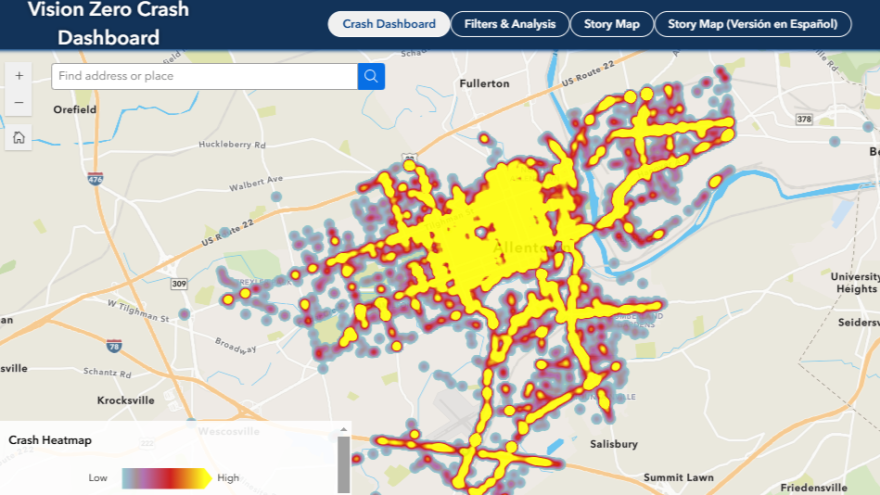ALLENTOWN, Pa. — A push to make Allentown’s roads safer is officially underway.
Officials met last April along Hanover Avenue to announce the Safe Streets and Road for All plan, which aims to eliminate all serious injuries and deaths on city roads by 2030.
Many gathered again Wednesday morning at Lehigh Parkway and South Jefferson Street, which Mayor Matt Tuerk called “the worst intersection in the universe.”
They celebrated a $1.9 million state grant to fund traffic-calming measures in the area with a middle-of-the-road event that kicked off the Safe Streets plan.
City Council on Wednesday night unanimously approved a resolution “granting effectivity” to the plan, formally launching it.
“These are not just numbers; these are real people."Chris Stanford, Michael Baker International
More than 8,600 crashes were reported on Allentown roads from 2019 to 2023, according to consultants Chris Stanford and Samantha McLean of Michael Baker International.
Almost 300 of those were classified as “high-injury,” meaning at least one person suffered a serious injury or died; and 69 crashes involved pedestrians.
Eleven people died in crashes in the city from 2019-23, the consultants’ data showed.
“These are not just numbers; these are real people,” Stanford said.
An online dashboard displaying more than 10,000 crashes in Allentown since 2019 includes a heat map that shows crashes on almost every block of the city in that period.
There are more than 400 miles of roads throughout Allentown.

Safe Streets + Vision Zero
A survey yielded more than 1,400 responses from residents, who identified speeding cars as the city’s biggest roadway-safety issue “by far,” McLean said.
Many also were concerned about a lack of bike lanes and safety features for pedestrians.
Fifty speed cushions are due to be placed on a dozen streets near schools and parks, thanks to a $384,000 federal grant to test potential safety upgrades.Allentown's Safe Streets plan
Allentown officials have also committed to ending pedestrian deaths through its Vision Zero strategy, which will work hand-in-hand with the Safe Streets initiative.
Consultants recommended a slew of potential roadway changes and upgrades, including “visual reminders” such as speed boards and flashing pedestrian-crossing signs, curb extensions, raised crosswalks and speed cushions.
Fifty speed cushions are due to be placed on a dozen streets near schools and parks, thanks to a $384,000 federal grant to test potential safety upgrades.
Crews also will use that money to create bike lanes and crosswalks on Jefferson Street and safety measures along a network of roads where most “high injury” crashes are recorded.
Roundabouts?
City officials also could look to reconfigure the layout of some streets. Tuerk said he wants to bring back two-way traffic in much of downtown Allentown.
Among the conceptual improvements used as examples for solutions at troublesome intersections are roundabouts.
The presentation included renderings of roundabouts on Hamilton Street, between Ott and 19th streets; and at the intersection of Union Boulevard, Airport Road and Irving Street.
According to the presentation, the roundabouts encourage improved safety from reduced speed; fewer conflict points; a reduced number of severe crashes; and improved pedestrian safety.
Educating people about roadway safety and enforcing traffic laws have long been priorities for Allentown officials, Tuerk said.
But engineering and designing roads to be safer will be a top priority of the city’s new initiative, too, he said.


